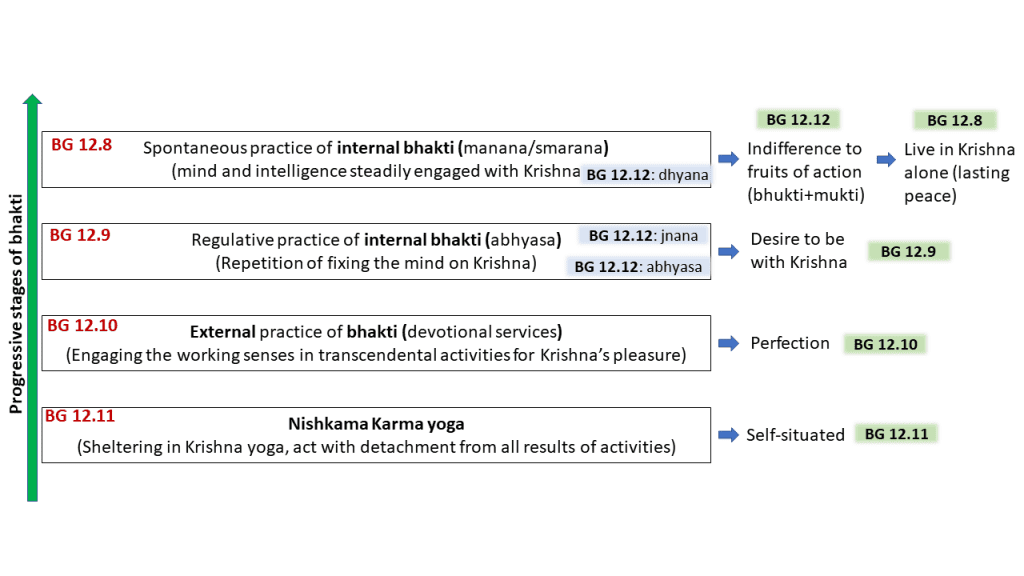After establishing the worship of the personal feature of Krishna by pure exclusive yoga to be most perfect, Krishna enumerates various forms of yoga (or means of connecting with God) from the highest to the lowest. The topmost yoga practice is to engage the mind and intelligence in Krishna. We should fix our mind (mana ādhatsva) in Krishna exclusively (mayy eva) and invest our intelligence (buddhiṁ niveśaya) in Krishna (mayi). Henceforward (ata ūrdhvaṁ), undoubtedly (na saṁśayaḥ), we will live (nivasiṣyasi) in Krishna exclusively (mayy eva). (BG 12.8) The highest stage is the spontaneous practice of internal bhakti yoga, where our mind and intelligence are naturally and steadily attracted to Krishna. This can also be considered to be the stage of manana (continuous fixing of the mind on Krishna), and smarana (constant remembrance of Krishna).
if (atha) we cannot (na śaknoṣi) fix (samādhātuṁ) the mind (cittaṁ) steadily (sthiram) upon Krishna (mayi), then (tato) we should take to the repetition of fixing the mind on Krishna (abhyāsa-yogena). In this way, we would develop a desire (icchāptuṁ) to attain Krishna (mām). (BG 12.9) This stage can be understood as the regulative practice of internal bhakti yoga. It is noteworthy that cittaṁ represents the emotive side of the mind. It deals with one’s intention and attention.
If we are not even able to practice this (abhyāse ’py asamartho ’si), then we should be dedicated to performing transcendental activities for Krishna (mat-karma-paramo bhava). By working (kurvan api) for the pleasure of Krishna (mad-artham karmāṇi), we will attain (avāpsyasi) perfection (siddhim). (BG 12.10) In other words, doing external practices of bhakti involving our working senses for Krishna’s pleasure would lead to perfection.
If, however, (atha) we are not even able to (apy aśakto ’si) do this (etad), we should act (kartuṁ), giving up all the results of our work (sarva-karma-phala-tyāgaṁ), taking shelter of (āśritaḥ) a form of yoga with Krishna (mad-yogam) [direct methods of connection], and thus (tataḥ) try to be self-situated (yatātmavān). (BG 12.11) This marks the platform of nishkama karma yoga (or karma yoga with detachment from all results of action).
Knowledge or awareness of Krishna (jñānam) is certainly better (śreyo hi) than external practice (abhyāsāj). Meditation (dhyānaṁ) or constant remembrance of Krishna is better (viśiṣyate) than mere knowledge (jñānād). Thereafter (anantaram), constant remembrance (dhyānāt) naturally leads to the renunciation of fruits of action (karma-phala-tyāgas) and renunciation leads to lasting peace (tyāgāc chāntir) or living with Krishna exclusively (as stated above). (BG 12.12)








